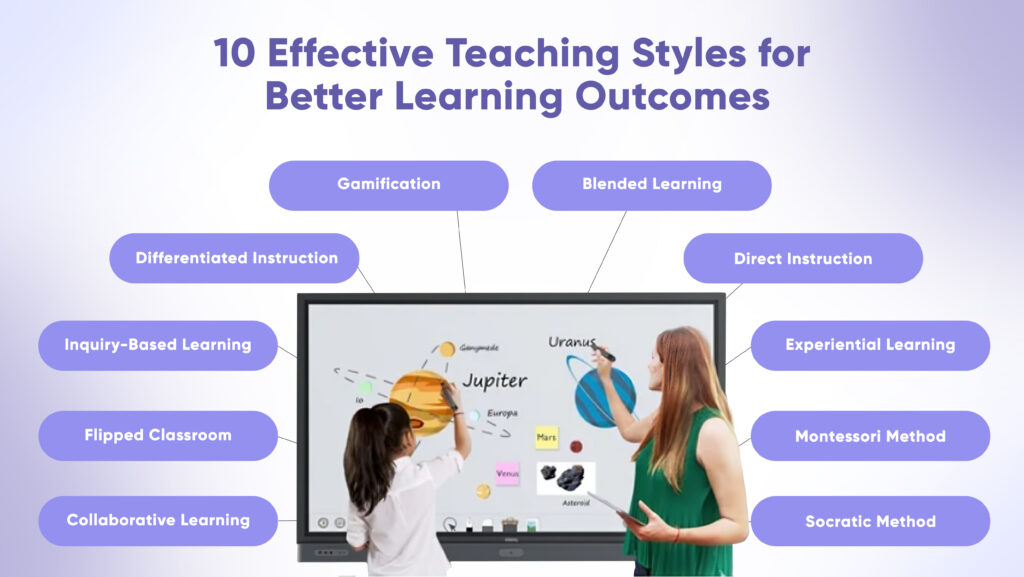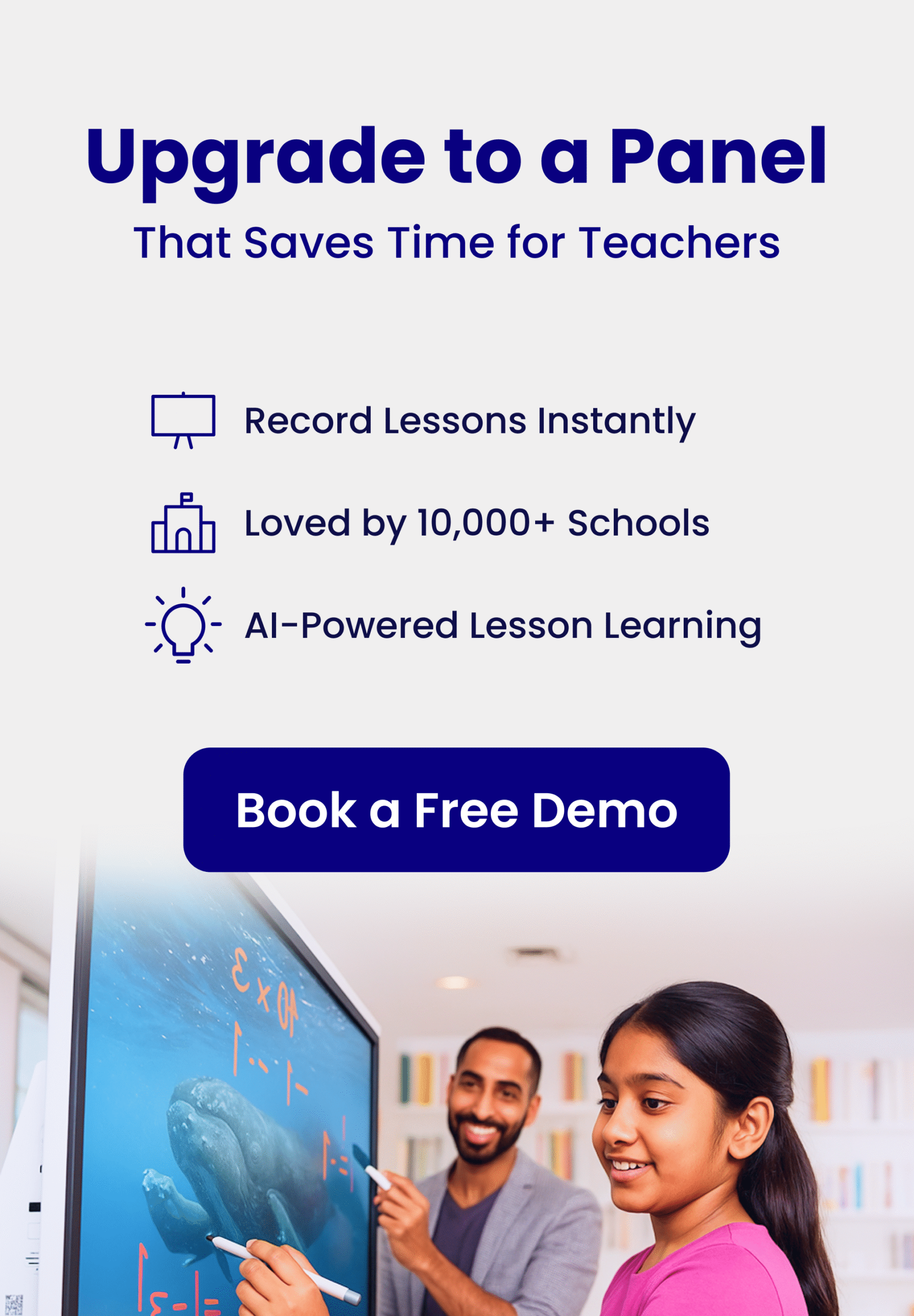Education isn’t one-size-fits-all. Just as every student is unique, so are the ways we teach them. Choosing the right teaching style can make all the difference. It sparks curiosity, boosting engagement and helping students grasp complex concepts.
According to a study by the University of Melbourne, teachers who adapt their teaching styles to their students’ needs see a 30% increase in student engagement. But how do you know which teaching style works best for your classroom?
In this blog, we’ll break down 10 effective teaching styles, explore their pros and cons, and share where they work best. Plus, we’ll have some expert tips to help you make the most of these styles. Let’s get started!
Key Takeaways:
- The right teaching style can boost engagement, improve outcomes, and build student confidence.
- Different styles work for different students, subjects, and classrooms.
- Combining styles like collaborative learning, gamification, and inquiry-based learning can create a more dynamic classroom.
- Tools like interactive flat panels enhance engagement and make lessons more interactive.
- Adapt your teaching style based on your student’s needs and feedback.
What Are Teaching Styles?
Teaching styles are the methods and approaches teachers use to deliver lessons and connect with their students. They shape how students learn, interact, and feel in the classroom. From traditional lectures to hands-on activities, each style has its own strengths and challenges.
The way you teach can make a big difference in how students absorb and retain information and stay motivated.
Also read: A Teacher’s Role in Classroom Management – Strategies for a Thriving Learning Environment
Benefits of Choosing the Right and Effective Teaching Style
The way you teach has a huge impact on your students’ learning experience. Picking the right teaching style helps students connect with the material, stay engaged, and achieve better results. Here’s why it’s so important:
10 Effective Teaching Styles with Pros, Cons, and Applicability
Let’s dive into the 10 most effective teaching styles, their pros and cons, and where they work best.

1. Collaborative Learning
What it is: Collaborative learning is a teaching style where students work together in small groups to solve problems, complete tasks, or discuss ideas. It emphasizes teamwork, communication, and shared responsibility for learning. This approach shifts the focus from the teacher to the students, encouraging them to learn from each other and build social skills.
Pros:
- Encourages teamwork and communication skills.
- Makes learning more interactive and engaging.
- Helps students develop problem-solving and conflict-resolution skills.
- Builds a sense of community in the classroom.
- Allows students to learn from diverse perspectives.
Cons:
- Can be challenging for introverted or shy students.
- Requires careful planning to ensure equal participation.
- Group dynamics can sometimes lead to conflicts or dominance by a few students.
- May take more time to cover the same material compared to traditional lectures.
- Assessment of individual contributions can be difficult.
Best used for:
- Group projects and presentations.
- Problem-solving activities in subjects like math or science.
- Discussions in literature, history, or social studies.
- Team-based competitions or challenges.
- Classrooms with a mix of skill levels to encourage peer learning.
Also read: Importance of Digital Collaboration in the Classroom and Its Benefits
2. Flipped Classroom
What it is: The flipped classroom model reverses traditional teaching methods. Students learn new content at home through videos, readings, or online modules, while class time is used for discussions, activities, and hands-on practice. This approach allows teachers to focus on applying knowledge rather than just delivering it.
Pros:
- Encourages independent learning and self-discipline.
- Maximizes classroom time for interactive and hands-on activities.
- Allows students to learn at their own pace at home.
- Provides more opportunities for one-on-one teacher-student interaction.
- Helps students take ownership of their learning process.
Cons:
- Requires access to technology and reliable internet at home.
- Can be challenging for students who struggle with self-motivation.
- Increases the workload for teachers to create or curate online content.
- May not work well for younger students who need more direct guidance.
- Not all subjects or topics are suitable for this approach.
Best used for:
- High school and college-level courses.
- STEM subjects where hands-on practice is crucial.
- Classrooms with access to digital tools and resources.
- Students who are comfortable with technology and independent learning.
- Teachers who want to focus on application rather than content delivery.
3. Inquiry-Based Learning
What it is: Inquiry-based learning is a student-centered approach where learning begins with questions, problems, or scenarios. Instead of being passive recipients of information, students actively explore topics, conduct research, and develop solutions. This style encourages curiosity, critical thinking, and problem-solving skills.
Pros:
- Encourages critical thinking and curiosity.
- Helps students take ownership of their learning.
- Develops research and analytical skills.
- Makes learning more engaging and relevant.
- Prepares students for real-world problem-solving.
Cons:
- Can be time-consuming to plan and execute.
- May not work for all subjects or age groups.
- Requires a high level of student motivation and self-direction.
- Can be challenging for teachers to manage and assess.
- May leave gaps in foundational knowledge if not balanced with direct instruction.
Best used for:
- Science experiments and research projects.
- Social studies and history investigations.
- Project-based learning environments.
- Classrooms with students who enjoy exploration and discovery.
- Advanced or gifted learners who thrive on challenges.
4. Differentiated Instruction
What it is: Differentiated instruction is a teaching approach where lessons are tailored to meet the diverse needs of students. It involves adjusting content, process, and assessment based on individual learning styles, abilities, and interests. This style ensures that every student, regardless of their pace or level, feels included and supported.
Pros:
- Addresses individual learning styles and abilities.
- Helps all students succeed, regardless of their starting point.
- Builds a more inclusive classroom environment.
- Encourages teachers to be creative and flexible.
- Increases student engagement and motivation.
Cons:
- Requires significant preparation and flexibility.
- Can be challenging in large classrooms with limited resources.
- May lead to uneven pacing if not managed carefully.
- Requires ongoing assessment and adjustment.
- Can be overwhelming for new or inexperienced teachers.
Best used for:
Mixed-ability classrooms.
- Subjects with diverse skill levels, like math or reading.
- Classrooms with students who have special needs or learning differences.
- Teachers who enjoy creative lesson planning.
- Schools with a focus on personalized learning.
5. Gamification
What it is: Gamification involves using game-like elements such as points, badges, leaderboards, and challenges to motivate students and make learning more engaging. Gamification in education turns lessons into interactive experiences, encouraging students to participate more.
Pros:
- Increases engagement and motivation.
- Makes learning fun and interactive.
- Encourages healthy competition and goal-setting.
- Helps students track their progress visually.
- Can be adapted to almost any subject or age group.
Cons:
- Can distract from the learning objectives if overused.
- May not appeal to all students, especially those who dislike competition.
- Requires careful design to ensure educational value.
- Can create pressure or stress for some students.
- May require additional resources or technology.
Best used for:
- Elementary and middle school classrooms.
- Subjects like math, language arts, or history.
- Classrooms with students who enjoy challenges.
- Teachers who want to incorporate technology into their lessons.
- Schools with access to digital tools and platforms.
Did You Know?
Gamification in education can increase student motivation by up to 60%. (Source: Vorecol)
Also read:
6. Blended Learning
What it is: Blended learning combines traditional face-to-face classroom teaching with online learning tools and resources. It allows students to learn at their own pace using digital platforms while still benefiting from in-person interactions with teachers and peers.
Pros:
- Offers flexibility and personalized learning paths.
- Prepares students for a tech-driven world.
- Allows teachers to track student progress more effectively.
- Combines the best of both online and offline learning.
- Encourages self-paced learning and independence.
Cons:
- Requires access to technology and reliable internet.
- Can be challenging to balance online and offline activities.
- May require additional training for teachers and students.
- Not all students thrive in self-directed learning environments.
- Can lead to screen fatigue if not managed properly.
Best used for:
- Schools with access to digital tools and resources.
- Subjects that benefit from multimedia content, like science or history.
- Classrooms with students who are comfortable with technology.
- Teachers who want to incorporate flipped classroom elements.
- Schools focusing on 21st-century skills and digital literacy.
7. Direct Instruction
What it is: Direct instruction is a teacher-centered approach where lessons are delivered in a clear, structured, and systematic way. The teacher explains concepts, demonstrates skills, and guides students through practice activities.
Pros:
- Provides clear explanations and step-by-step guidance.
- Works well for introducing new concepts or skills.
- Ensures consistency in content delivery.
- Easy to implement and assess.
- Effective for foundational subjects like math and grammar.
Cons:
- Can be less engaging for students.
- Limits student interaction and creativity.
- May not cater to diverse learning styles.
- Can feel repetitive or monotonous over time.
- Less effective for advanced or exploratory topics.
Best used for:
- Foundational subjects like math, reading, and grammar.
- Classrooms with students who need clear, structured guidance.
- Teachers who prefer a straightforward, no-frills approach.
- Schools with limited resources or technology.
- Lessons that require step-by-step skill-building.
8. Experiential Learning
What it is: Experiential learning focuses on learning through hands-on experiences and real-world applications. It encourages students to actively engage with the material, reflect on their experiences, and apply what they’ve learned in practical situations.
Pros:
- Helps students connect theory to practice.
- Encourages problem-solving and critical thinking.
- Makes learning more memorable and impactful.
- Builds real-world skills and confidence.
- Engages students who learn best by doing.
Cons:
- Requires time and resources to organize.
- May not work for all topics or subjects.
- Can be logistically challenging to implement.
- Requires careful planning to ensure learning objectives are met.
- May not suit students who prefer structured, theoretical learning.
Best used for:
- Science experiments and lab work.
- Field trips and outdoor learning activities.
- Vocational training and skill-based subjects.
- Classrooms with access to hands-on resources.
- Teachers who enjoy creative, interactive lesson planning.
9. Montessori Method
What it is: The Montessori method is a student-centered approach that emphasizes self-directed learning in a prepared environment. Students choose their activities from a range of options, working independently or in small groups, while teachers act as guides rather than traditional instructors.
Pros:
- Encourages independence and self-discipline.
- Creates a love for learning through exploration.
- Tailors learning to individual interests and paces.
- Develops problem-solving and critical thinking skills.
- Creates a calm, focused learning environment.
Cons:
- Requires specialized training and materials.
- May not align with standardized testing requirements.
- Can be challenging to implement in traditional school systems.
- May not suit students who need more structure or guidance.
- Limited focus on group collaboration or teamwork.
Best used for:
- Early childhood education (ages 3–6).
- Classrooms with a focus on individualized learning.
- Schools with trained Montessori teachers.
- Students who thrive in self-directed environments.
- Parents and educators who value holistic, child-centered education.
10. Socratic Method
What it is: The Socratic method is a teaching style based on asking and answering questions to stimulate critical thinking and draw out ideas. Instead of lecturing, the teacher facilitates discussions, encouraging students to analyze concepts, challenge assumptions, and articulate their thoughts.
Pros:
- Encourages critical thinking and active participation.
- Helps students articulate and defend their ideas.
- Builds strong communication and reasoning skills.
- Creates a dynamic, interactive classroom environment.
- Prepares students for debates and advanced discussions.
Cons:
- Can be intimidating for shy or introverted students.
- Requires skilled facilitation to keep discussions on track.
- May not work for all subjects or age groups.
- Can be time-consuming compared to direct instruction.
- May leave gaps in foundational knowledge if not supplemented.
Best used for:
- Philosophy, law, and ethics classes.
- Advanced discussions in literature or social studies.
- Classrooms with mature, confident students.
- Teachers who enjoy facilitating open-ended discussions.
- Schools with a focus on critical thinking and debate.
As seen above the majority of the effective teaching style promote interactive learning. Interactive teaching-learning is the demand of today’s classroom to prepare students for tomorrow.

Quick Expert Tips to Make Your Teaching Styles More Effective
- Don’t stick to just one style. Combine different approaches to keep your classroom dynamic and engaging.
- Use Technology and tools like interactive flat panels. These will enhance engagement and make lessons more interactive.
- Seek Feedback by regularly asking students for input to refine your teaching methods.
- Stay Flexible and readily adapt your style based on your student’s needs and the lesson at hand.
- Focus on Inclusivity to ensure your teaching style caters to diverse learning needs and abilities.
Make Your Teaching Style More Effective with Senses
Teaching is both an art and a science. By understanding the pros and cons of different teaching styles, you can create a classroom environment where every student thrives. Whether you’re flipping your classroom, experimenting with gamification, or choosing to go with collaborative learning, it is important to stay flexible and responsive to your students’ needs.
And remember, the right tools can make all the difference.
With Senses Electronics’ interactive flat panels, you can bring out the maximum output from your teaching. These Interactive panels are loaded with features to make your teaching more effective and learning fun for your students.
Want to know how Senses do it all? Schedule a demo call now
FAQs
Teaching styles are the methods and approaches teachers use to deliver lessons and connect with students. They shape how students learn, interact, and feel in the classroom.
The right teaching style boosts engagement, improves learning outcomes, and helps students feel confident and supported. It also caters to diverse learning needs and prepares students for real-world challenges.
There’s no one-size-fits-all answer. The most effective style depends on your students’ needs, the subject, and your teaching goals. A mix of styles often works best.
Tools like interactive flat panels can make lessons more engaging, interactive, and tailored to individual learning needs. They’re especially useful for styles like collaborative learning, flipped classrooms, and gamification.
Absolutely! Combining styles like collaborative learning, differentiated instruction, and gamification can create a dynamic and inclusive learning environment.





